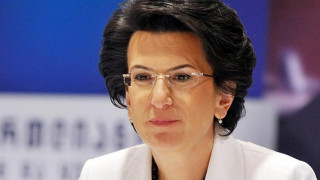On 17 February 2016, regarding the difficulties in supplying Abkhazia with electricity, Democratic Movement Head, Nino Burjanadze, stated: "Resolving the problems of Abkhazia and Samachablo is not even a priority for this government, let alone the main one. The government’s decision, according to which the supply of electricity to Abkhazia will be halted, proves this once again."
FactCheck looked into this issue.
According to a verbal agreement reached in 1997, about 40% of the electricity generated by the Inguri HPP would be used to supply occupied Abkhazia whilst the remaining 60% would be used according to the needs of the rest of Georgia. This energy is the only local source for supplying the Autonomous Republic of Abkhazia with electricity. The Inguri HPP’s dam is situated in the Municipality of Tsalenjikha whilst the generators are located in the Municipality of Gali. Hence, the two essential units comprising the entire system are located on opposite sides of the occupation line. The basis of the 1997 agreement was precisely the shared distribution of the overall energy resources between the territories controlled by the central government and those controlled by the Abkhazian separatist government. It should be noted that due to the low consumption of the Autonomous Republic of Abkhazia over several years following the 1997 agreement, its share of the energy was not being entirely used.
Table 1: Share of Consumption of the Autonomous Republic of Abkhazia in the Combined Amounts of Electricity Generated by the Inguri HPP and the Vardnili HPP
Source: Electricity Market Operator
The consumption of electricity on the territory of occupied Abkhazia increased over time. Given the disorderly manner of accounting and the high level of energy losses caused by the faulty internal network, the 40% envisaged by the agreement turned out to be insufficient in order to fully meet consumption needs. Hence, a decision was made to supply more than 40% of the electricity to Abkhazia in the peak periods of the year whilst the initially agreed 40% would be supplied during non-peak periods. With the exception of 2013, the annual share of electricity consumed by the Autonomous Republic of Abkhazia exceeded 40% of production during the years 2011 to 2015. Furthermore, almost the whole amount of electricity generated by the Inguri HPP went to the occupied region during the peak periods in the winter season (see Chart 1). According to the data of January 2016, about 94% of the total production was spent on supplying the Autonomous Republic of Abkhazia.
Chart 1: Electricity Consumption of the Autonomous Republic of Abkhazia in the Overall Production of the Inguri HPP and the Vardnili HPP
 Source: Electricity Market Operator
After the first large influx of water, the dam fell 15 metres short of being filled to the top in August 2015 given the meteorological conditions in the period from 2013 to 2015 (light snow in 2013 and 2014 and a summer drought in 2015). Because of the droughts in September and October 2015, the second (smaller) influx of water was not able to correct the imbalance in the water level which lowered the amount of electricity which the Inguri HPP could generate. The Autonomous Republic of Abkhazia’s consumption grew in parallel with the dam’s decreased generating output. As a result, the overall amount of electricity generated by the Inguri HPP was insufficient to meet Abkhazia’s consumption needs which led to the necessity of supplying the region according to a delivery schedule. Given the lowered influx characteristic of the winter season, the level of water in the Inguri dam was lowered to 443.62 metres above sea level in February 2016. According to the Inguri HPP’s technical parameters, a minimum water level for safe operation is 440 metres although it is possible to continue operation until a level of 420 metres in an emergency mode. According to the statement of an Inguri HPP spokesman, Levan Mebonia, the decision was made to operate at the lower water level although consumption needs could only be met until February 2016 even with February’s additional water influx. Afterwards, the electricity generated using the current influx of water is only enough to meet 30% of the electricity consumption needs of the Autonomous Republic of Abkhazia.
Given this situation, there was a danger that the Autonomous Republic of Abkhazia would be left without electricity; however, according to the decision of the central government of Georgia, the electricity necessary for Abkhazia’s consumption needs would be imported from the Russian Federation. This political decision is a continuation of the current practices (the consumption needs of the occupied region have been met by importing electricity from Russia on numerous occasions).
It should also be pointed out that the electricity deficit will only increase if the current consumption practices of the Autonomous Republic of Abkhazia are maintained with the deficit becoming impossible to remedy with short-term operative solutions. The situation is further complicated by the need for the rehabilitation of the Inguri HPP’s hydro-technical buildings; namely, the 12 cubic metre per second water loss in the damaged derivation tunnels (for comparison, the current influx was only 22 cubic metres per second in February). According to the statement of the Inguri HPP’s General Director, about three-and-a-half to four months will be necessary to repair the critical damage whilst the entire rehabilitation process could take anywhere from two to two-and-a-half years (see link).
Of additional particular mention is the process’s financial aspect. The Inguri HPP tariff for 1 kWh of energy generated is 1.187 tetri and the Vardnili HPP tariff for 1 kWh of energy generated is 1.17 tetri although the Abkhazian side does not pay for the electricity it consumes from these HPPs. As a result, the Inguri HPP’s income per generated kWh is approximately 0.71 tetri according to the 40:60 distribution agreement and this income remains on the decrease with the growth of the Autonomous Republic of Abkhazia’s electricity consumption.
Furthermore, the Abkhazian side does not participate in those activities aimed at maintaining the operation of the Inguri HPP. The solving of the identified problems, the planned work, rehabilitation or any other cost associated with the operation of the HPP is covered from the sales of surplus energy resources. The Inguri HPP operates with virtually no income whatsoever during the winter period and takes short-term loans in order to cover its expenditures. The loans are serviced and the HPP operates without any problems throughout the year by exporting surplus energy during non-peak months. It should also be noted that Georgia does not possess any alternative inexpensive resource to cover the share of electricity which the Autonomous Republic of Abkhazia uses at the expense of that which is directed to the rest of Georgia. Georgia is, therefore, forced to import electricity from the Russian Federation at a much higher price in order to rectify the shortfall.
Conclusion
The Autonomous Republic of Abkhazia is supplied with 40% of the electricity generated by the Inguri HPP cascade free-of-charge. A decision was made to supply more electricity to Abkhazia than originally stated in the 1997 verbal agreement in response to its consumption needs in the past few years. It should also be pointed out that the Inguri HPP’s running costs are covered from the sales of surplus generated energy whilst Abkhazia gets its share of energy for free. As things stand, the Autonomous Republic of Abkhazia’s current consumption level exceeds the Inguri HPP’s current production. Given the dam’s low water levels, electricity production after February 2016 was to be continued based upon the current influx of water which would only be sufficient to cover only a small portion of Abkhazia’s consumption needs.
Hence, according to the decision of the Ministry of Energy of Georgia, the existing shortfall will be remedied by importing electricity from Russia, as has been the established practise, in order to avoid a stoppage of the electricity supply to the region.
Hence, FactCheck concludes that Nino Burjanadze’s statement is a LIE.
Source: Electricity Market Operator
After the first large influx of water, the dam fell 15 metres short of being filled to the top in August 2015 given the meteorological conditions in the period from 2013 to 2015 (light snow in 2013 and 2014 and a summer drought in 2015). Because of the droughts in September and October 2015, the second (smaller) influx of water was not able to correct the imbalance in the water level which lowered the amount of electricity which the Inguri HPP could generate. The Autonomous Republic of Abkhazia’s consumption grew in parallel with the dam’s decreased generating output. As a result, the overall amount of electricity generated by the Inguri HPP was insufficient to meet Abkhazia’s consumption needs which led to the necessity of supplying the region according to a delivery schedule. Given the lowered influx characteristic of the winter season, the level of water in the Inguri dam was lowered to 443.62 metres above sea level in February 2016. According to the Inguri HPP’s technical parameters, a minimum water level for safe operation is 440 metres although it is possible to continue operation until a level of 420 metres in an emergency mode. According to the statement of an Inguri HPP spokesman, Levan Mebonia, the decision was made to operate at the lower water level although consumption needs could only be met until February 2016 even with February’s additional water influx. Afterwards, the electricity generated using the current influx of water is only enough to meet 30% of the electricity consumption needs of the Autonomous Republic of Abkhazia.
Given this situation, there was a danger that the Autonomous Republic of Abkhazia would be left without electricity; however, according to the decision of the central government of Georgia, the electricity necessary for Abkhazia’s consumption needs would be imported from the Russian Federation. This political decision is a continuation of the current practices (the consumption needs of the occupied region have been met by importing electricity from Russia on numerous occasions).
It should also be pointed out that the electricity deficit will only increase if the current consumption practices of the Autonomous Republic of Abkhazia are maintained with the deficit becoming impossible to remedy with short-term operative solutions. The situation is further complicated by the need for the rehabilitation of the Inguri HPP’s hydro-technical buildings; namely, the 12 cubic metre per second water loss in the damaged derivation tunnels (for comparison, the current influx was only 22 cubic metres per second in February). According to the statement of the Inguri HPP’s General Director, about three-and-a-half to four months will be necessary to repair the critical damage whilst the entire rehabilitation process could take anywhere from two to two-and-a-half years (see link).
Of additional particular mention is the process’s financial aspect. The Inguri HPP tariff for 1 kWh of energy generated is 1.187 tetri and the Vardnili HPP tariff for 1 kWh of energy generated is 1.17 tetri although the Abkhazian side does not pay for the electricity it consumes from these HPPs. As a result, the Inguri HPP’s income per generated kWh is approximately 0.71 tetri according to the 40:60 distribution agreement and this income remains on the decrease with the growth of the Autonomous Republic of Abkhazia’s electricity consumption.
Furthermore, the Abkhazian side does not participate in those activities aimed at maintaining the operation of the Inguri HPP. The solving of the identified problems, the planned work, rehabilitation or any other cost associated with the operation of the HPP is covered from the sales of surplus energy resources. The Inguri HPP operates with virtually no income whatsoever during the winter period and takes short-term loans in order to cover its expenditures. The loans are serviced and the HPP operates without any problems throughout the year by exporting surplus energy during non-peak months. It should also be noted that Georgia does not possess any alternative inexpensive resource to cover the share of electricity which the Autonomous Republic of Abkhazia uses at the expense of that which is directed to the rest of Georgia. Georgia is, therefore, forced to import electricity from the Russian Federation at a much higher price in order to rectify the shortfall.
Conclusion
The Autonomous Republic of Abkhazia is supplied with 40% of the electricity generated by the Inguri HPP cascade free-of-charge. A decision was made to supply more electricity to Abkhazia than originally stated in the 1997 verbal agreement in response to its consumption needs in the past few years. It should also be pointed out that the Inguri HPP’s running costs are covered from the sales of surplus generated energy whilst Abkhazia gets its share of energy for free. As things stand, the Autonomous Republic of Abkhazia’s current consumption level exceeds the Inguri HPP’s current production. Given the dam’s low water levels, electricity production after February 2016 was to be continued based upon the current influx of water which would only be sufficient to cover only a small portion of Abkhazia’s consumption needs.
Hence, according to the decision of the Ministry of Energy of Georgia, the existing shortfall will be remedied by importing electricity from Russia, as has been the established practise, in order to avoid a stoppage of the electricity supply to the region.
Hence, FactCheck concludes that Nino Burjanadze’s statement is a LIE.
| Year | Consumption of the Autonomous Republic of Abkhazia | Combined Production of Inguri and Vardnili HPPs | Share of the Autonomous Republic of Abkhazia in the Overall Production |
| 2007 | 1,255.30 | 3,410.90 | 36.80% |
| 2008 | 1,272.90 | 3,690.70 | 34.49% |
| 2009 | 1,358.30 | 3,502.40 | 38.78% |
| 2010 | 1,377.10 | 5,032.50 | 27.36% |
| 2011 | 1,613.37 | 3,845.86 | 41.95% |
| 2012 | 1,533.66 | 3,759.32 | 40.80% |
| 2013 | 1,605.28 | 4,272.33 | 37.57% |
| 2014 | 1,638.60 | 3,966.00 | 41.32% |
| 2015 | 1,797.20 | 3,905.90 | 46.01% |
 Source: Electricity Market Operator
After the first large influx of water, the dam fell 15 metres short of being filled to the top in August 2015 given the meteorological conditions in the period from 2013 to 2015 (light snow in 2013 and 2014 and a summer drought in 2015). Because of the droughts in September and October 2015, the second (smaller) influx of water was not able to correct the imbalance in the water level which lowered the amount of electricity which the Inguri HPP could generate. The Autonomous Republic of Abkhazia’s consumption grew in parallel with the dam’s decreased generating output. As a result, the overall amount of electricity generated by the Inguri HPP was insufficient to meet Abkhazia’s consumption needs which led to the necessity of supplying the region according to a delivery schedule. Given the lowered influx characteristic of the winter season, the level of water in the Inguri dam was lowered to 443.62 metres above sea level in February 2016. According to the Inguri HPP’s technical parameters, a minimum water level for safe operation is 440 metres although it is possible to continue operation until a level of 420 metres in an emergency mode. According to the statement of an Inguri HPP spokesman, Levan Mebonia, the decision was made to operate at the lower water level although consumption needs could only be met until February 2016 even with February’s additional water influx. Afterwards, the electricity generated using the current influx of water is only enough to meet 30% of the electricity consumption needs of the Autonomous Republic of Abkhazia.
Given this situation, there was a danger that the Autonomous Republic of Abkhazia would be left without electricity; however, according to the decision of the central government of Georgia, the electricity necessary for Abkhazia’s consumption needs would be imported from the Russian Federation. This political decision is a continuation of the current practices (the consumption needs of the occupied region have been met by importing electricity from Russia on numerous occasions).
It should also be pointed out that the electricity deficit will only increase if the current consumption practices of the Autonomous Republic of Abkhazia are maintained with the deficit becoming impossible to remedy with short-term operative solutions. The situation is further complicated by the need for the rehabilitation of the Inguri HPP’s hydro-technical buildings; namely, the 12 cubic metre per second water loss in the damaged derivation tunnels (for comparison, the current influx was only 22 cubic metres per second in February). According to the statement of the Inguri HPP’s General Director, about three-and-a-half to four months will be necessary to repair the critical damage whilst the entire rehabilitation process could take anywhere from two to two-and-a-half years (see link).
Of additional particular mention is the process’s financial aspect. The Inguri HPP tariff for 1 kWh of energy generated is 1.187 tetri and the Vardnili HPP tariff for 1 kWh of energy generated is 1.17 tetri although the Abkhazian side does not pay for the electricity it consumes from these HPPs. As a result, the Inguri HPP’s income per generated kWh is approximately 0.71 tetri according to the 40:60 distribution agreement and this income remains on the decrease with the growth of the Autonomous Republic of Abkhazia’s electricity consumption.
Furthermore, the Abkhazian side does not participate in those activities aimed at maintaining the operation of the Inguri HPP. The solving of the identified problems, the planned work, rehabilitation or any other cost associated with the operation of the HPP is covered from the sales of surplus energy resources. The Inguri HPP operates with virtually no income whatsoever during the winter period and takes short-term loans in order to cover its expenditures. The loans are serviced and the HPP operates without any problems throughout the year by exporting surplus energy during non-peak months. It should also be noted that Georgia does not possess any alternative inexpensive resource to cover the share of electricity which the Autonomous Republic of Abkhazia uses at the expense of that which is directed to the rest of Georgia. Georgia is, therefore, forced to import electricity from the Russian Federation at a much higher price in order to rectify the shortfall.
Conclusion
The Autonomous Republic of Abkhazia is supplied with 40% of the electricity generated by the Inguri HPP cascade free-of-charge. A decision was made to supply more electricity to Abkhazia than originally stated in the 1997 verbal agreement in response to its consumption needs in the past few years. It should also be pointed out that the Inguri HPP’s running costs are covered from the sales of surplus generated energy whilst Abkhazia gets its share of energy for free. As things stand, the Autonomous Republic of Abkhazia’s current consumption level exceeds the Inguri HPP’s current production. Given the dam’s low water levels, electricity production after February 2016 was to be continued based upon the current influx of water which would only be sufficient to cover only a small portion of Abkhazia’s consumption needs.
Hence, according to the decision of the Ministry of Energy of Georgia, the existing shortfall will be remedied by importing electricity from Russia, as has been the established practise, in order to avoid a stoppage of the electricity supply to the region.
Hence, FactCheck concludes that Nino Burjanadze’s statement is a LIE.
Source: Electricity Market Operator
After the first large influx of water, the dam fell 15 metres short of being filled to the top in August 2015 given the meteorological conditions in the period from 2013 to 2015 (light snow in 2013 and 2014 and a summer drought in 2015). Because of the droughts in September and October 2015, the second (smaller) influx of water was not able to correct the imbalance in the water level which lowered the amount of electricity which the Inguri HPP could generate. The Autonomous Republic of Abkhazia’s consumption grew in parallel with the dam’s decreased generating output. As a result, the overall amount of electricity generated by the Inguri HPP was insufficient to meet Abkhazia’s consumption needs which led to the necessity of supplying the region according to a delivery schedule. Given the lowered influx characteristic of the winter season, the level of water in the Inguri dam was lowered to 443.62 metres above sea level in February 2016. According to the Inguri HPP’s technical parameters, a minimum water level for safe operation is 440 metres although it is possible to continue operation until a level of 420 metres in an emergency mode. According to the statement of an Inguri HPP spokesman, Levan Mebonia, the decision was made to operate at the lower water level although consumption needs could only be met until February 2016 even with February’s additional water influx. Afterwards, the electricity generated using the current influx of water is only enough to meet 30% of the electricity consumption needs of the Autonomous Republic of Abkhazia.
Given this situation, there was a danger that the Autonomous Republic of Abkhazia would be left without electricity; however, according to the decision of the central government of Georgia, the electricity necessary for Abkhazia’s consumption needs would be imported from the Russian Federation. This political decision is a continuation of the current practices (the consumption needs of the occupied region have been met by importing electricity from Russia on numerous occasions).
It should also be pointed out that the electricity deficit will only increase if the current consumption practices of the Autonomous Republic of Abkhazia are maintained with the deficit becoming impossible to remedy with short-term operative solutions. The situation is further complicated by the need for the rehabilitation of the Inguri HPP’s hydro-technical buildings; namely, the 12 cubic metre per second water loss in the damaged derivation tunnels (for comparison, the current influx was only 22 cubic metres per second in February). According to the statement of the Inguri HPP’s General Director, about three-and-a-half to four months will be necessary to repair the critical damage whilst the entire rehabilitation process could take anywhere from two to two-and-a-half years (see link).
Of additional particular mention is the process’s financial aspect. The Inguri HPP tariff for 1 kWh of energy generated is 1.187 tetri and the Vardnili HPP tariff for 1 kWh of energy generated is 1.17 tetri although the Abkhazian side does not pay for the electricity it consumes from these HPPs. As a result, the Inguri HPP’s income per generated kWh is approximately 0.71 tetri according to the 40:60 distribution agreement and this income remains on the decrease with the growth of the Autonomous Republic of Abkhazia’s electricity consumption.
Furthermore, the Abkhazian side does not participate in those activities aimed at maintaining the operation of the Inguri HPP. The solving of the identified problems, the planned work, rehabilitation or any other cost associated with the operation of the HPP is covered from the sales of surplus energy resources. The Inguri HPP operates with virtually no income whatsoever during the winter period and takes short-term loans in order to cover its expenditures. The loans are serviced and the HPP operates without any problems throughout the year by exporting surplus energy during non-peak months. It should also be noted that Georgia does not possess any alternative inexpensive resource to cover the share of electricity which the Autonomous Republic of Abkhazia uses at the expense of that which is directed to the rest of Georgia. Georgia is, therefore, forced to import electricity from the Russian Federation at a much higher price in order to rectify the shortfall.
Conclusion
The Autonomous Republic of Abkhazia is supplied with 40% of the electricity generated by the Inguri HPP cascade free-of-charge. A decision was made to supply more electricity to Abkhazia than originally stated in the 1997 verbal agreement in response to its consumption needs in the past few years. It should also be pointed out that the Inguri HPP’s running costs are covered from the sales of surplus generated energy whilst Abkhazia gets its share of energy for free. As things stand, the Autonomous Republic of Abkhazia’s current consumption level exceeds the Inguri HPP’s current production. Given the dam’s low water levels, electricity production after February 2016 was to be continued based upon the current influx of water which would only be sufficient to cover only a small portion of Abkhazia’s consumption needs.
Hence, according to the decision of the Ministry of Energy of Georgia, the existing shortfall will be remedied by importing electricity from Russia, as has been the established practise, in order to avoid a stoppage of the electricity supply to the region.
Hence, FactCheck concludes that Nino Burjanadze’s statement is a LIE.
Tags:








